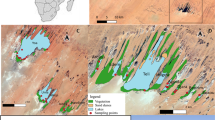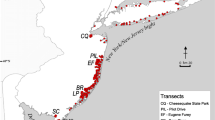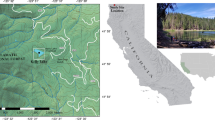Abstract
Despite a relatively large number of paleoenvironmental and archaeological studies in the Southern Urals, Russia, Holocene moisture dynamics in the region remain a subject of debate. Electrical conductivity (EC) of lake waters in the Southern Urals is climate-dependent and associated with effective moisture. I developed a transfer function using a 72-lake regional diatom dataset and inferred past EC using diatoms in sediment cores from three lakes. The diatom-inferred EC inferences were compared with pollen records to validate the climate interpretation and explore the possible influence of vegetation on lake hydrochemistry. Multivariate analysis showed a clear response of diatom communities to electrical conductivity across a range from 55 to 3780 μS cm−1. The best electrical conductivity inference model (r2boot = 0.78, RMSEPboot = 0.21 log10 μS cm−1), suitable for quantitative reconstructions, was developed using weighted averaging with classical deshrinking. Application of the transfer function to sediment cores from mountain lakes in the forest and forest-steppe regions of the Southern Urals revealed relations between EC and variations in pollen contents of herbs, pine (for the forest-steppe lake) and spruce (for the forest lakes). Although a decrease in EC may be attributable to coniferous forest spread in the watersheds, it is more likely that climate fluctuations caused the coincident shifts in vegetation and lake-water hydrochemistry. Forest lakes were marked by a declining trend in EC since the beginning of the Holocene (11.9–11.5 cal ka BP), which was independent of the larch and birch forest distribution (11.5–10.0 cal ka BP) and was interrupted by minor climate-driven EC increases. Electrical conductivity of lake water was higher than present in the period between 6.5 and 3.8 cal ka BP in all three study lakes. Forest lakes were characterized by gradual increases and decreases in EC, with maximum values occurring ca. 5.0–4.0 cal ka BP. Diatoms in the core from the forest-steppe lake record variations in EC through time. In particular, the record shows highest EC values at 5.3 cal ka BP, a decline in EC at 4.1–3.8 cal ka BP, a slight increase about 3.6 cal ka BP and a substantial decrease since 2.8 cal ka BP.




Similar content being viewed by others
References
Andreeva MA (1973) Ozera Srednego i Juzhnogo Urala (Middle and Southern Urals lakes). Southern Urals Books Press, Chelyabinsk (in Russian)
Appleby PG, Oldfield F (1978) The calculation of lead–210 dates assuming a constant rate of supply of the unsupported lead–210 to the sediment. CATENA 5:1–8. https://doi.org/10.1016/S0341-8162(78)80002-2
Birks HJB (1998) Numerical tools in palaeolimnology—progress, potentialities, and problems. J Paleolimnol 20:307–332. https://doi.org/10.1023/A:1008038808690
Birks HJB, Line JM, Juggins S, Stephenson AC, ter Braak CJF (1990) Diatoms and pH reconstruction. Philos Trans R Soc Lond B Biol Sci 327:263–278. https://doi.org/10.1098/rstb.1990.0062
Blaauw M, Christen AJ (2011) Flexible paleoclimate age-depth models using an autoregressive gamma process. Bayesian Anal 6(3):457–474. https://doi.org/10.1214/11-BA618
Cornet C, Subires J (1995) How to distinguish Stephanodiscus parvus Stoermer & Hakansson from Stephanodiscus minutulus (Kutz.) Cleve & Moller? Vie Milieu 45:273–277
Cumming BF, Laird KR, Gregory-Eaves I, Simpson KJ, Sokal MA, Nordin RN, Walker IR (2015) Tracking past changes in lake-water phosphorus with a 251-lake calibration dataset in British Columbia: tool development and application in a multiproxy assessment of eutrophication and recovery in Osoyoos Lake, a transboundary lake in Western North America. Front Ecol Evol 3:1–18. https://doi.org/10.3389/fevo.2015.00084
Davies SJ, Metcalfe SE, Caballero ME, Juggins S (2002) Developing diatom-based transfer functions for Central Mexican lakes. Hydrobiologia 467:199–213. https://doi.org/10.1023/A:1014971016298
Demezhko DY, Golovanova IV (2007) Climatic changes in the Urals over the past millennium—an analysis of geothermal and meteorological data. Clim Past 3:237–242. https://doi.org/10.5194/cp-3-237-2007
Deryagin VV, Maslennikova AV, Deryagin AV (2011) Rezhimy osadkonakopleniya v ozerah Serebry i Syrytkul (Juzhnyi Ural) [Sedimentation in lakes Serebry and Syrytkul (Southern Urals)]. Vestnik CSU 5:24–30 (in Russian)
Ermanov N (2010) Corresponding geographical types of hemiboreal forests in North Asia: peculiarities of ecology and genesis. Phytocoenologia 40:29–40. https://doi.org/10.1127/0340-269X/2010/0040-0433
Fritz SC, Anderson NJ (2013) The relative influences of climate and catchment processes on Holocene lake development in glaciated regions. J Paleolimnol 49:349–362. https://doi.org/10.1007/s10933-013-9684-z
Fritz SC, Juggins S, Battarbee RW (1993) Diatom assemblages and ionic characterization of lakes of the Northern Great Plains, North America: a tool for reconstructing past salinity and climate fluctuations. Can J Fish Aquat Sci 50:1844–1856. https://doi.org/10.1139/f93-207
Gasse F, Juggins S, Ben Khelifa L (1995) Diatom-based transfer functions for inferring past hydrochemical characteristics of African lakes. Palaeogeogr Palaeoclimatol Palaeoecol 117:31–54. https://doi.org/10.1016/0031-0182(94)00122-O
Gell PA (1997) The development of a diatom database for inferring lake salinity, Western Victoria, Australia: towards a quantitative approach for reconstructing past climates. Aust J Bot 45:389–423. https://doi.org/10.1071/bt96036
Genkal SI (2013) Morphological variability, taxonomy, and ecology of species of the complex Handmannia comta/H. radiosa (Bacillariophyta). Int J Algae 15:331–354. https://doi.org/10.1615/InterJAlgae.v15.i4.30
Guiry MD, Guiry GM (2019) AlgaeBase. World-wide electronic publication, National University of Ireland, Galway. https://www.algaebase.org
Herzschuh U, Pestryakova LA, Savelieva LA, Heinecke L, Böhmer T, Biskaborn BK, Andreev A, Ramisch A, Shinneman AL, Birks HJ (2013) Siberian larch forests and the ion content of thaw lakes form a geochemically functional entity. Nat Commun 4:2408. https://doi.org/10.1038/ncomms3408
Ivanov IV, Prikhodko VE, Zamotaev IV, Manakhov DV, Novenko EYu, Kalinin PI, Markova LM, Plaksina AL (2019) Synlithogenic evolution of floodplain soils in valleys of small rivers in the trans-ural steppe. Eurasian Soil Sci 52:593. https://doi.org/10.1134/S1064229319060061
Juggins S (2007) C2 version 1.5 user guide. Software for ecological and palaeoecological data analysis and visualisation. Newcastle University, Newcastle Upon Tyne
Juggins S (2013) Quantitative reconstructions in paleolimnology: new paradigm or sick science? Quat Sci Rev 64:20–32. https://doi.org/10.1016/j.quascirev.2012.12.014
Khokhlova OS, Morgunova NL, Khokhlov AA, Gol'eva AA (2018) Climate and vegetation changes over the past 7000 years in the cis-ural steppe. Eurasian Soil Sci 51:506–517. https://doi.org/10.1134/S106422931805006X
Kremenetski CV, Chichagova OA, Shishlina NI (1999) Palaeoecological evidence for Holocene vegetation, climate and land-use change in the low Don basin and Kalmuk area, southern Russia. Veget Hist Archaebot 8:233. https://doi.org/10.1007/BF01291776
Kulikovskiy MS, Glushechenko AM, Genkal SI, Kuznetsova IV (2016) Identification book of diatoms from Russia. Filigran, Yaroslavl (in Russian)
Laird KR, Fritz SC, Cumming BF, Grimm EC (1998) Early-holocene limnological and climatic variability in the Northern Great Plains. Holocene 8:275–285. https://doi.org/10.1191/095968398673895438
Lapteva EG, Korona OM (2012) Holocene vegetation changes and anthropogenic influence in the forest-steppe zone of the Southern Trans-Urals based on pollen and plant macrofossil records from the Sukharysh cave. Veget Hist Archaeobot 21:321–336. https://doi.org/10.1007/s00334-011-0333-z
Leps J, Smilauer P (2003) Multivariate analysis of ecological data using CANOCO. Cambridge University Press, New York
Maslennikova AV, Udachin VN (2017) Lakes ecosystem response to Holocene climate changes and human impact in the Southern Urals: diatom and geochemical proxies. Holocene 27:847–859. https://doi.org/10.1177/0959683616675942
Maslennikova AV, Udachin VN, Deryagin VV (2013) Lake Talkas (Southern Urals) sedimentation environments in Holocene. Bull Soc Imp Nat Mos Geol Sect 88:53–60 (in Russian)
Maslennikova AV, Udachin VN, Deryagin VV (2014) Paleoekologia i geokhimia ozernoi sedimentatsii golotsena Urala [Paleoecology and geochemistry of the lake sedimentation of the Urals]. Editing and publishing department UB RAS, Yekaterinburg (in Russian)
Maslennikova AV, Udachin VN, Aminov PG (2016a) Lateglacial and Holocene environmental changes in the Southern Urals reflected in palynological, diatom, geochemical records from the Lake Syrytkul sediments. Quat Int 420:65–75. https://doi.org/10.1016/j.quaint.2015.08.062
Maslennikova AV, Udachin VN, Anfilogov VN, Deryagin VV (2016b) Reflection of global Late Glacial and Holocene paleoclimate oscillations in the palynological record from bottom sediments of Tavatui Lake (Middle Urals). Dokl Earth Sci 468:553–556. https://doi.org/10.1134/S1028334X16060040
Morales EA, Wetzel CE, Haworth EY, Ector L (2019) Ending a 175-year taxonomic uncertainty: Description of Staurosirella neopinnata sp. nov. (Bacillariophyta) to accommodate Fragilaria pinnata, a highly misconstrued taxon with a purported worldwide distribution. Phytotaxa 402:75–87. https://doi.org/10.11646/phytotaxa.402.2.1
Murav'ev AG (ed) (2011) Rukovodstvo po analizu vody. Pit'evaya i prirodnaya voda, pochvennye vytyazhki [Guide to water analysis. Drinking and natural water, soil extracts]. Krismas+, St. Petersburg (in Russian)
Palagushkina OV, Nazarova LB, Wetterich S, Schirrmeister L (2012) Diatoms of modern bottom sediments in Siberian arctic. Contemp Probl Ecol 5:413–422. https://doi.org/10.1134/S1995425512040105
Panova NK (1982) Istorija gornyh lesov central'noj chasti Juzhnogo Urala v golotsene [History of mountain forests in the Southern Urals central part in Holocene]. Lesovedenie 1:26–34 (in Russian)
Panova NK, Antipina TG (2016) Late Glacial and Holocene environmental history on the eastern slope of the middle ural mountains, Russia. Quat Int 420:76–89. https://doi.org/10.1016/j.quaint.2015.10.035
Pestryakova LA, Herzschuh U, Gorodnichev R, Wetterich S (2018) The sensitivity of diatom taxa from Yakutian lakes (north-eastern Siberia) to electrical conductivity and other environmental variables. Polar Res 37:1. https://doi.org/10.1080/17518369.2018.1485625
Prikhod’ko EV, Ivanov IV, Manakhov DV, Gerasimenko NP, Inubushi K, Kawahigashi M, Nagano K, Sugihara S (2013) Soils, vegetation, and climate of the Southern Transural region in the Middle Bronze Age (be the example of the Arkaim fortress). Eurasian Soil Sci 46:925–934. https://doi.org/10.1134/S1064229313090032
Reed JM (1998) A diatom-conductivity transfer function for Spanish salt lakes. J Paleolimnol 19:399–416. https://doi.org/10.1023/A:1007934627134
Reed JM, Mesquita-Joanes F, Griffiths HI (2012) Multi-indicator conductivity transfer functions for quaternary palaeoclimate reconstruction. J Paleolimnol 47:251–275. https://doi.org/10.1007/s10933-011-9574-1
Rioual P, Lu Y, Yang H, Scuderi L, Chu G, Holmes J, Zhu B, Yang X (2013) Diatom–environment relationships and a transfer function for conductivity in lakes of the Badain Jaran Desert, Inner Mongolia, China. J Paleolimnol 50:207–229. https://doi.org/10.1007/s10933-013-9715-9
Ryabogina NE, Afonin AS, Ivanov SN, Li H-C, Kalinin PA, Udaltsov SN, Nikolaenko SA (2019) Holocene paleoenvironmental changes reflected in peat and lake sediment records of Western Siberia: geochemical and plant macrofossil proxies. Quat Int. https://doi.org/10.1016/j.quaint.2019.04.006
Ryves DB, McGowan S, Anderson NJ (2002) Development and evaluation of a diatom-conductivity model from lakes in West Greenland. Freshw Biol 47:995–1014. https://doi.org/10.1046/j.1365-2427.2002.00832.x
Saunders KM (2011) A diatom dataset and diatom-salinity inference model for southeast Australian estuaries and coastal lakes. J Paleolimnol 46:525–542. https://doi.org/10.1007/s10933-010-9456-y
Shinneman ALC, Edlund MB, Almendinger JE, Soninkhishig N (2009) Diatoms as indicators of water quality in Western Mongolian lakes: a 54-site calibration set. J Paleolimnol 42:373–389. https://doi.org/10.1007/s10933-008-9282-7
Shinneman ALC, Bennett DM, Fritz SC, Schmieder J, Engstrom DR, Efting A, Holz J (2010) Inferring lake depth using diatom assemblages in the shallow, seasonally variable lakes of the Nebraska Sand Hills (USA): calibration, validation, and application of a 69-lake training set. J Paleolimnol 44:443–464. https://doi.org/10.1007/s10933-010-9427-3
Schönfelder I, Gelbrecht J, Schönfelder J, Steinberg CEW (2002) Relationships between littoral diatoms and their chemical environment in northeastern German lakes and rivers. J Phycol 38:66–82. https://doi.org/10.1046/j.1529-8817.2002.01056.x
Stobbe A, Gumnior M, Rühl L, Schneider H (2016) Bronze Age human–landscape interactions in the southern Transural steppe, Russia—evidence from high-resolution palaeobotanical studies. Holocene 26:1692–1710. https://doi.org/10.1177/0959683616641740
Stewart RE, Kantrud HA (1971) Classification of natural ponds and lakes in the Glaciated Prairie Region. Resource Publication 92, Bureau of Sport Fisheries and Wildlife, US Fish and Wildlife Service, Washington, DC
ter Braak CJF (1988) CANOCO—a FORTRAN Program for Canonical Community Ordination by [Partial] [Detrended] [Canonical] correspondence analysis, principal components analysis and redundancy analysis (version 2.1). Technical report LWA-88-02. Agricultural Mathematics Group, Wageningen
ter Braak CJF, Juggins S (1993) Weighted averaging partial least-squares regression (WA-PLS)—an improved method for reconstructing environmental variables from species assemblages. Hydrobiologia 269:485–502. https://doi.org/10.1007/BF00028046
ter Braak CJF, Prentice IC (1988) A theory of gradient analysis. Adv Ecol Res 18:271–317
ter Braak CJF, Smilauer P (2002) CANOCO reference manual and CanoDraw for windows user’s guide: software for canonical community ordination (version 4.5). Microcomputer Power, Ithaca
Verleyen E, Hodgson DA, Vyverman W, Roberts D, McMinn A, Vanhoutte K, Sabbe K (2003) Modelling diatom responses to climate induced fluctuations in the moisture balance in continental Antarctic lakes. J Paleolimnol 30:195–215. https://doi.org/10.1023/A:1025570904093
Volik O, Petrone RM, Hall RI, Macrae ML, Wells CM, Elmes MC, Price JS (2017) Long-term precipitation-driven salinity change in a saline, peat-forming wetland in the Athabasca Oil Sands Region, Canada: a diatom-based paleolimnological study. J Paleolimnol 58:533–550. https://doi.org/10.1007/s10933-017-9989-4
Wang R, Yang X, Langdon P, Zhang E (2011) Limnological responses to warming on the Xizang Plateau, Tibet, over the past 200 years. J Paleolimnol 45:257–271. https://doi.org/10.1007/s10933-011-9496-y
Wilson SE, Cumming BF, Smol JP (1996) Assessing the reliability of salinity inference models from diatom assemblages: an examination of a 219-lake data set from western North America. Can J Fish Aquat Sci 53:1580–1594. https://doi.org/10.1139/f96-094
Yang XD, Kamenik C, Schmidt R, Wang S (2003) Diatom-based conductivity and water-level inference models from eastern Tibetan (Qinghai–Xizang) Plateau lakes. J Paleolimnol 30:1–19. https://doi.org/10.1023/A:1024703012475
Zhilina TN (2012) Prirodno-klimaticheskie usloviya 1550–1850 gg. kak faktor riska razvitiya sel'skogo hozyajstva v Zapadnoj Sibiri [Natural and climatic conditions of 1550–1850 AD as a risk factor for agricultural development in Western Siberia] Vestnik Tomskogo gosudarstvennogo universiteta [Tomsk State University Journal] 354:77–80 (in Russian)
Acknowledgements
I thank Galina Lonshchakova and Lyudmila Udachina (South Urals Research Center of Mineralogy and Geoecology UB RAS) for generous help with analytical work, Vasily Gulakov, Pavel Aminov (South Urals Research Center of Mineralogy and Geoecology UB RAS) and Vladimir Deryagin (South Ural State Humanitarian Pedagogical University) for help with field work, Valery Udachin (South Urals Research Center of Mineralogy and Geoecology UB RAS) for help with 210Pb dating, and Elena Maslennikova for recommendations that improved the text. I am grateful to the reviewers of this paper for their valuable advice and constructive remarks. I am also grateful to Mark Brenner for editorial assistance. This work was funded by the Russian Science Fund (Grant No. 18–77-00040). Chronology of the cores was supported by the State Contract of South Urals Research Center of Mineralogy and Geoecology UB RAS.
Author information
Authors and Affiliations
Corresponding author
Additional information
Publisher's Note
Springer Nature remains neutral with regard to jurisdictional claims in published maps and institutional affiliations.
Electronic supplementary material
Below is the link to the electronic supplementary material.
Rights and permissions
About this article
Cite this article
Maslennikova, A.V. Development and application of an electrical conductivity transfer function, using diatoms from lakes in the Urals, Russia. J Paleolimnol 63, 129–146 (2020). https://doi.org/10.1007/s10933-019-00106-z
Received:
Accepted:
Published:
Issue Date:
DOI: https://doi.org/10.1007/s10933-019-00106-z




